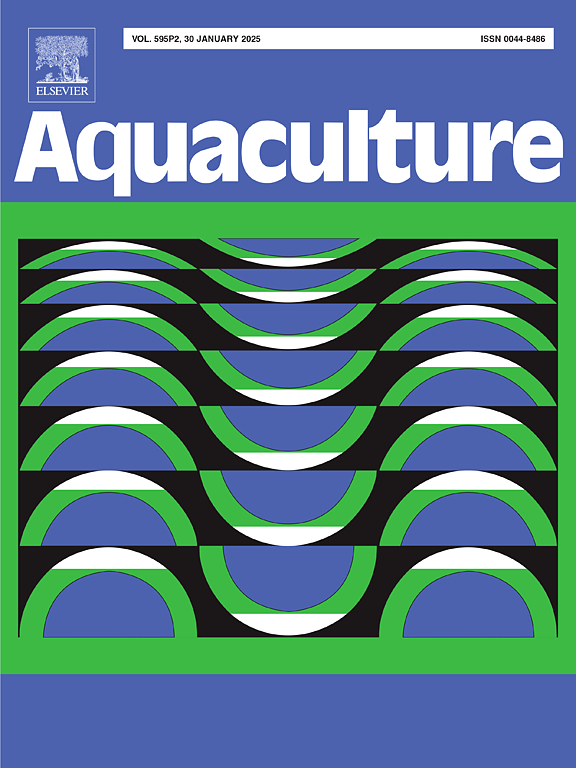Tank- and cage-farmed Atlantic salmon display similar swimming performance and appetite recovery despite differences in gill and heart morphology
IF 3.9
1区 农林科学
Q1 FISHERIES
引用次数: 0
Abstract
Understanding Atlantic salmon physiology is essential for ensuring welfare in aquaculture. Many physiological studies used to establish welfare standards have relied on fish reared in controlled tank settings, yet commercial production occurs in more variable sea cage environments. This raises the question of whether tank-reared salmon serve as reliable models for performance and health assessments of sea cage-reared populations. We compared swimming performance, stress recovery, and morphology between two groups of farmed Atlantic salmon: one reared entirely in tanks and another transferred to sea cages at ∼100 g, where they remained for 8 months. Both groups displayed comparable swimming performances and similarly high motivation to feed after 1 week following exhaustive exercise, with no post-exercise mortality observed. However, sea cage-reared salmon had a slower trajectory to recover their appetite and worse snout and skin welfare, suggesting more challenging recovery conditions at sea. Morphological analysis revealed potential trade-offs in gill and heart health: tank-reared salmon had signs of healthier gills but a higher incidence of deviating heart morphology. Unexpectedly, salmon with rounder heart ventricles and more obtuse ventricular bulbus angles swam faster relative to their body size, challenging previous findings and underscoring the need for further investigation into the functional significance of heart morphology. Our results highlight the resilience of sea cage-reared salmon and affirm the role of laboratory tank studies in aquaculture research, especially when complemented by site-specific assessments to bridge experimental and commercial contexts.
水箱和笼养大西洋鲑鱼表现出相似的游泳性能和食欲恢复,尽管鳃和心脏形态不同
了解大西洋鲑鱼的生理机能对确保水产养殖的福利至关重要。许多用于建立福利标准的生理研究依赖于在受控水族箱环境中饲养的鱼,然而商业生产发生在更可变的海笼环境中。这就提出了一个问题,即水箱饲养的鲑鱼是否可以作为海洋笼养种群的性能和健康评估的可靠模型。我们比较了两组养殖大西洋鲑鱼的游泳性能、应激恢复和形态:一组完全在水箱中饲养,另一组以100克的重量转移到海笼中,在那里停留8个月。两组在剧烈运动1周后均表现出相当的游泳表现和同样高的进食动力,未观察到运动后死亡。然而,海笼饲养的鲑鱼恢复食欲的轨迹较慢,鼻子和皮肤的健康状况也较差,这表明海上的恢复条件更具挑战性。形态学分析揭示了鳃和心脏健康的潜在权衡:水箱养殖的鲑鱼有更健康的鳃的迹象,但心脏形态偏离的发生率更高。出乎意料的是,心脏心室更圆、心室球角更钝的鲑鱼相对于它们的体型游得更快,这挑战了之前的发现,并强调了进一步研究心脏形态功能意义的必要性。我们的研究结果强调了海洋笼养鲑鱼的恢复能力,并肯定了实验室水箱研究在水产养殖研究中的作用,特别是当有特定地点的评估作为补充时,以架起实验和商业背景的桥梁。
本文章由计算机程序翻译,如有差异,请以英文原文为准。
求助全文
约1分钟内获得全文
求助全文
来源期刊

Aquaculture
农林科学-海洋与淡水生物学
CiteScore
8.60
自引率
17.80%
发文量
1246
审稿时长
56 days
期刊介绍:
Aquaculture is an international journal for the exploration, improvement and management of all freshwater and marine food resources. It publishes novel and innovative research of world-wide interest on farming of aquatic organisms, which includes finfish, mollusks, crustaceans and aquatic plants for human consumption. Research on ornamentals is not a focus of the Journal. Aquaculture only publishes papers with a clear relevance to improving aquaculture practices or a potential application.
 求助内容:
求助内容: 应助结果提醒方式:
应助结果提醒方式:


